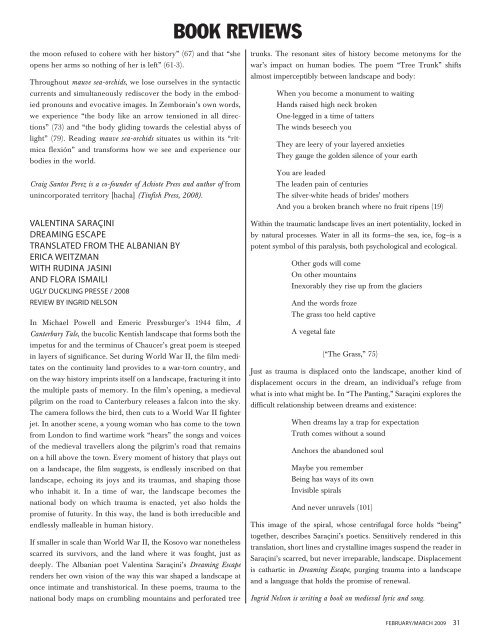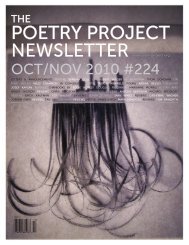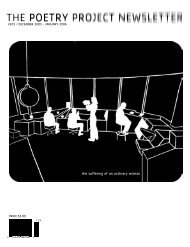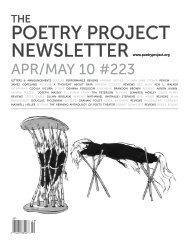Download PDF - The Poetry Project
Download PDF - The Poetry Project
Download PDF - The Poetry Project
You also want an ePaper? Increase the reach of your titles
YUMPU automatically turns print PDFs into web optimized ePapers that Google loves.
BOOK REVIEWSthe moon refused to cohere with her history” (67) and that “sheopens her arms so nothing of her is left” (61-3).Throughout mauve sea-orchids, we lose ourselves in the syntacticcurrents and simultaneously rediscover the body in the embodiedpronouns and evocative images. In Zemborain’s own words,we experience “the body like an arrow tensioned in all directions”(73) and “the body gliding towards the celestial abyss oflight” (79). Reading mauve sea-orchids situates us within its “rítmicaflexión” and transforms how we see and experience ourbodies in the world.Craig Santos Perez is a co-founder of Achiote Press and author of fromunincorporated territory [hacha] (Tinfish Press, 2008).Valentina SaraçiniDreaming EscapeTranslated from the Albanian byErica Weitzmanwith Rudina Jasiniand Flora IsmailiUgly Duckling Presse / 2008Review by Ingrid NelsonIn Michael Powell and Emeric Pressburger’s 1944 film, ACanterbury Tale, the bucolic Kentish landscape that forms both theimpetus for and the terminus of Chaucer’s great poem is steepedin layers of significance. Set during World War II, the film meditateson the continuity land provides to a war-torn country, andon the way history imprints itself on a landscape, fracturing it intothe multiple pasts of memory. In the film’s opening, a medievalpilgrim on the road to Canterbury releases a falcon into the sky.<strong>The</strong> camera follows the bird, then cuts to a World War II fighterjet. In another scene, a young woman who has come to the townfrom London to find wartime work “hears” the songs and voicesof the medieval travellers along the pilgrim’s road that remainson a hill above the town. Every moment of history that plays outon a landscape, the film suggests, is endlessly inscribed on thatlandscape, echoing its joys and its traumas, and shaping thosewho inhabit it. In a time of war, the landscape becomes thenational body on which trauma is enacted, yet also holds thepromise of futurity. In this way, the land is both irreducible andendlessly malleable in human history.If smaller in scale than World War II, the Kosovo war nonethelessscarred its survivors, and the land where it was fought, just asdeeply. <strong>The</strong> Albanian poet Valentina Saraçini’s Dreaming Escaperenders her own vision of the way this war shaped a landscape atonce intimate and transhistorical. In these poems, trauma to thenational body maps on crumbling mountains and perforated treetrunks. <strong>The</strong> resonant sites of history become metonyms for thewar’s impact on human bodies. <strong>The</strong> poem “Tree Trunk” shiftsalmost imperceptibly between landscape and body:When you become a monument to waitingHands raised high neck brokenOne-legged in a time of tatters<strong>The</strong> winds beseech you<strong>The</strong>y are leery of your layered anxieties<strong>The</strong>y gauge the golden silence of your earthYou are leaded<strong>The</strong> leaden pain of centuries<strong>The</strong> silver-white heads of brides’ mothersAnd you a broken branch where no fruit ripens (19)Within the traumatic landscape lives an inert potentiality, locked inby natural processes. Water in all its forms—the sea, ice, fog—is apotent symbol of this paralysis, both psychological and ecological.Other gods will comeOn other mountainsInexorably they rise up from the glaciersAnd the words froze<strong>The</strong> grass too held captiveA vegetal fate(“<strong>The</strong> Grass,” 75)Just as trauma is displaced onto the landscape, another kind ofdisplacement occurs in the dream, an individual’s refuge fromwhat is into what might be. In “<strong>The</strong> Panting,” Saraçini explores thedifficult relationship between dreams and existence:When dreams lay a trap for expectationTruth comes without a soundAnchors the abandoned soulMaybe you rememberBeing has ways of its ownInvisible spiralsAnd never unravels (101)This image of the spiral, whose centrifugal force holds “being”together, describes Saraçini’s poetics. Sensitively rendered in thistranslation, short lines and crystalline images suspend the reader inSaraçini’s scarred, but never irreparable, landscape. Displacementis cathartic in Dreaming Escape, purging trauma into a landscapeand a language that holds the promise of renewal.Ingrid Nelson is writing a book on medieval lyric and song.february/march 2009 31
















